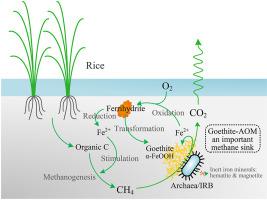Soil Biology and Biochemistry ( IF 9.8 ) Pub Date : 2021-08-07 , DOI: 10.1016/j.soilbio.2021.108387 Zhanfei He 1 , Yinghong Zhu 1 , Jieni Feng 1 , Qingqing Ji 1 , Xin Chen 1 , Xiangliang Pan 1, 2

|
Due to a suitable ecological environment, the iron-dependent anaerobic oxidation of methane (Fe-AOM) occurs in paddy soil, reducing methane emissions to the atmosphere. Paddy soil contains a variety of iron minerals whose effects on Fe-AOM remain unclear. Here, paddy soil in the ferruginous zone was collected, and four environment-related iron minerals (ferrihydrite, goethite, hematite, and magnetite) were used as electron acceptors to cultivate Fe-AOM for 380 days. The Fe-AOM activity and microbial community structure were monitored using isotope activity assays and molecular biological methods, including quantitative polymerase chain reaction (qPCR) and high-throughput sequencing. The inoculum Fe-AOM rate was the highest with ferrihydrite, followed by goethite, hematite, and magnetite. However, it was ranked in the order goethite > ferrihydrite > hematite > magnetite after long-term cultivation. The specific activity of goethite-dependent AOM increased 14.2 times (from 0.9 ± 0.2 to 12.9 ± 0.4 nmol d−1 g−1 dry soil) during the 380 days, while that of ferrihydrite increased by only 1.2 times (from 7.9 ± 2.4 to 9.1 ± 0.3 nmol d−1 g−1 dry soil). The microbial community changed significantly after the emendation of ferrihydrite or goethite, while the other two did not. This implies that ferrihydrite and goethite had a significant impact on microbial processes, including Fe-AOM. Notably, although ferrihydrite promoted Fe-AOM, its reduction product of Fe(II) greatly stimulated methanogenesis and increased methane emission, whereas goethite was able to reduce methane emissions and did not stimulate methanogenesis. Thus, these findings indicate that goethite-dependent AOM occurs in paddy soils and, although previously overlooked, is a crucial sink of the global methane cycle.
中文翻译:

四种环境相关铁矿物对稻田中甲烷微生物厌氧氧化的长期影响:以前被忽视的广泛针铁矿的作用
由于适宜的生态环境,在稻田土壤中发生依赖铁的甲烷厌氧氧化(Fe-AOM),减少了向大气中排放的甲烷。水稻土含有多种铁矿物质,其对 Fe-AOM 的影响尚不清楚。在这里,收集了铁质区的稻田土壤,以四种与环境相关的铁矿物(水铁矿、针铁矿、赤铁矿和磁铁矿)为电子受体,培育 Fe-AOM 380 天。使用同位素活性测定和分子生物学方法监测 Fe-AOM 活性和微生物群落结构,包括定量聚合酶链反应 (qPCR) 和高通量测序。接种物 Fe-AOM 率以水铁矿最高,其次是针铁矿、赤铁矿和磁铁矿。但是,它的排列顺序是针铁矿 > 水铁矿 > 赤铁矿 > 磁铁矿经过长期栽培。针铁矿依赖的AOM比活增加了14.2倍(从0.9±0.2到12.9±0.4 nmol d-1 g -1干燥土壤)在 380 天期间,而水铁矿的增加仅 1.2 倍(从 7.9 ± 2.4 到 9.1 ± 0.3 nmol d -1 g -1干土)。水铁矿或针铁矿改良后微生物群落发生了显着变化,而其他两种则没有。这意味着水铁矿和针铁矿对包括 Fe-AOM 在内的微生物过程有显着影响。值得注意的是,虽然水铁矿促进了 Fe-AOM,但其 Fe(II) 的还原产物极大地刺激了甲烷生成并增加了甲烷排放,而针铁矿能够减少甲烷排放并且没有刺激甲烷生成。因此,这些发现表明针铁矿依赖的 AOM 发生在稻田土壤中,虽然以前被忽视,但它是全球甲烷循环的关键汇。





















































 京公网安备 11010802027423号
京公网安备 11010802027423号